Mobile Data - Information is in the Air !
Written by Gavin Thomas, Mercury Communications.
� Mercury Communications Ltd - June 1994
![]() GSM pico cell's moment of fame - March 2007
GSM pico cell's moment of fame - March 2007
![]() 2007
network writings:
2007
network writings:
![]() My
TechnologyInside blog
My
TechnologyInside blog
Mobile data services have been predicted to be the next communications boom market for some time now with many analysts expecting dramatic growth in the market over the next five years. The reason for this prediction is straightforward - people, being inherently mobile and increasingly information hungry, are expecting to be able to access, send and receive what they want, where and when they find it most convenient.
Corporate users have been the first to experience the benefits of mobility with portable computers and mobile 'phones. They have been the main market for mobile data applications in the past and will continue to be in the near future. Consumers also are becoming increasingly familiar with the concept of untethered actions, through their increasing use of cordless telephone handsets at home, cellular phones, pagers, and obligatory remote controls for their television, video and stereo.
To the mobile telecommunications world, voice telephony has been the driving force. All energies have been directed at putting smaller and cheaper portable telephones into everyone's hand. Data is at best a differentiating feature, at worst a costly extra. But to the portable computing world, communications is the holy grail of the future - and considerable effort is being expended on their part to conquer this fresh lucrative market. Companies are fighting over themselves to identify real needs and achieve truly mobile applications.
This Technology Watch will explore and position some of the applications and the multitude of methods for implementing mobile data communications (in its broadest sense) within the UK.
How mobile is mobile ?
Mobility means different things to different people, and there are many definitions of mobile data, ranging from; one-way pagers, sending faxes over cellular networks, wireless connections to a LAN, to general portability using a laptop PC plugged into a hotel room phone socket.
The degree of mobility required varies considerably with a particular application and user's requirements, but can be split into two domains; wide area and local area communications. Devices capable of operating in either domain will most probably need dual interfaces to accommodate the very different characteristics of the data.
Communications over a wide area
This covers world-wide communications, in remote locations, in flight, at sea, across Europe, in a single country or within a town. Requiring physical infrastructure such as a dedicated cellular network, or even a satellite network in space, they are at present characterised by low data rates (typically less than 15 kbits/s), normally with subscription and usage-based tariffs.
Local area communications
These include communications within a building, across the desk or office (e.g. wireless extension to a LAN), or across a meeting table. Much higher data rates are achievable with localised expenditure on equipment usually the only cost of service.
The Mobile Ingredients
There are a number of key elements necessary to provide a suitable mobile data solution to a specified need -
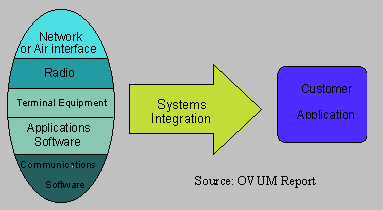
Figure 1 - The Mobile Ingredients
Mobile data applications
There are some very different requirements for mobile data, however applications can be divided into three broad categories -
Transaction applications
These provide limited person to person communications, normally consisting of two messages: one to request an operation and another to signal the success or failure of the operation. Examples include; messaging, E-mail (a common first application due to low data transmission requirements), fax transmission, general file transfer, fleet management and Point-Of-Sales (POS) credit card validation.
Interactive applications
Usually involve multiple message exchanges between a mobile unit and remote computer or LAN. Examples include database enquiry or update and remote LAN access, for example to -
- provide a corporate sales force with access to up-to-date customer information.
- provide instant on-the-spot insurance quotes or pensions advice by being able to consult the office database remotely and log prospect's details.
Broadcast applications
Here messages are transmitted to many users falling within a wide area, delivered to a limited geographic area or to a user group. Messages are not acknowledged and only a premium rate is paid, not an expensive per-user rate. Paging networks are ideally suited for broadcasting general information and news services e.g. BBC Newsflashes, FT share prices, sporting information, bomb alerts.
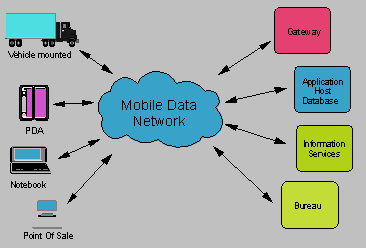
Figure 2 - Some mobile data applications
Wide Area Mobile Data Networks
There are a number of methods for implementing mobile communications over a wide area including cellular, paging, dedicated data services, Private Mobile Radio and satellite services. These can be divided into two categories, networks offering purely data services (usually packet data) and circuit switched voice networks offering data services via a modem.
Data over analogue cellular
This is perhaps the most obvious, but arguably the least suitable method of transmitting data. Armed with an interface, modem and mobile phone, data at a continuous rate between 1.2 and 2.4 kbit/s can be sent over the analogue cellular networks using circuit switching techniques.
The major problem with this technique is overcoming the variable radio path conditions and the temporary connection loss at handover between cells. Comprehensive error correction and a very robust protocol limits the usable data rate available. However a number of (incompatible) protocols have emerged that do the job -
Vodafone have offered Millidyne�s Cellular Data Link Control (CDLC) since 1986 which transmits data twice for high in-built redundancy giving 2.4kbit/s circuit switched data.
Cellular Digital Packet Data (CDPD) or CelluPlan II is a new open industry standard for data over the cellular network. It fills the inherent inefficiencies (using 30 seconds of channel idle time) of existing cellular systems with individual 19.2kbit/s packets, although data cannot be sent from a handset while it is being used for voice communications. It is getting a lot of support from manufacturers and looks set to take off very soon.
Some disadvantages of data over analogue cellular are the need to match a variety of equipment together at both ends for compatibility, costly tarrifs, coupled with an expected trend towards digital cellular networks in the near future. However, workable solutions are available today which bundle together in a briefcase a notebook, mobile phone and cellular interface.
Digital Cellular
There are two European digital cellular systems, the digital mobile standard GSM and the PCN standard DCS 1800 (see Technology Watch #15). They have been designed primarily for voice communications but their digital functionality would seem ideally suited to mobile data communications.
The GSM specifications define various data capabilities between users including -
- 9.6kbit/s circuit switched data and group III fax.
- text messaging using its Short Message Service (SMS) to deliver upto 160 characters to individual mobiles or broadcast 82 characters to a group of users. Message receipt is provided and preliminary trials have been completed.
- Packet switched data (X.25) and asynchronous transmission is currently being developed, should be ready in 1996.
Many GSM networks have been launched or are being built across Europe and elsewhere, but operators have implemented a stripped down specification covering voice-only communications at present to limit the high infrastructure development costs.
In the UK, Vodafone have built their Micro Cellular Network (MCN) which uses standard GSM with micro cells to provide much denser coverage, smaller cells and lower power handsets. Voice telephony has been operational for over one year with coverage now in most locations. SMS data messaging is expected soon.
DCS 1800 is based on the GSM specifications, but operates at higher frequencies in smaller cells with smaller, lower power, cheaper handsets. The UK already has Mercury's One2One PCN network which only supports voice at present. Hutchison Microtel is due to launch their PCN soon and promises a virtually national coverage. Although much is uncertain at present with problems offering 9.6kbit/s data, PCN networks are likely to offer better in-building coverage than standard cellular or mobile data systems because of their microcell based design. It is also possible that in the long term they will make it easier to provide seamless coverage between local and wide area networks.
There are a number of advantages for data users with GSM technology. The well-adopted standard allows inter-country mobility and should ensure wide equipment availability with terminal price economies. GSM also has sophisticated in-built security arrangements such as encryption and smart card authentication procedures. However since still very new, there is an immediate shortage of terminals and some concern over interference problems. The data rates while better than other wide area systems are still relatively low.
Paging
Traditional paging offers one way, low data rate information transfer. There are three types of pager available: tone-only, numeric, and alpha-numeric. Tone pagers are the cheapest and least intelligent, offering a bleep, LED flash or vibrate to the user. A numeric pager will display upto 20 digits, such as a telephone number or digit-coded message. The alpha-numeric pager typically allows four lines of 20 character text on its LCD display. Some, such as Mercury's Advisor are fitted with memory to store 40 separate messages with each message upto 400 characters long.
Messages are communicated to the pager by calling a bureau operator who keys in the message for transmission over the network. An alternative method which bypasses the bureau uses a DTMF telephone to send common pre-formed messages. NEC programme their Alpha pagers with 63 messages e.g. "Call Client", "meeting scheduled for...", "please call...". Users dial the pager network followed by a number corresponding to the message required.
Four paging operators run networks in the UK: Mercury Paging (recently merged with Inter-City Paging), BT Paging, Hutchison Paging and Vodapage (recently taken over Aircall). A paging network consists of numerous base stations spread across the UK. Every message is simultaneously broadcast using the POCSAG protocol at 1,200 bit/s over low power VHF channels from each base station. Mercury and Hutchison differ from BT and Vodapage in their method of distributing data to base stations. They use a satellite down link rather than conventional leased land-lines to simplify the synchronisation of data transmissions from each base station.
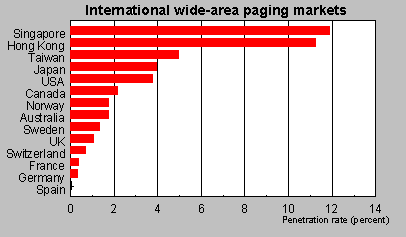
Figure 3 - Worldwide paging penetrations
Pagers have become extremely popular with consumers in Asia Pacific. Not quite so in UK, where there are approximately 750,000 pagers in use. They have mainly found niche markets, being ideal for certain applications such as field engineer messaging and in the emergency services.
However this is likely to change as the market broadens in the UK and the trend in personal use increases. Pagers are already available in High Streets at suitable prices with Mercury and others selling through Dixons. Mercury's Bravo Express pagers are brightly coloured and positioned as fashionable accessories useful for contacting friends and relatives. In the USA, credit card and wristwatch pagers are available from supermarkets and some are marketed as devices allowing parents to stay in touch with their children.
Enhanced Paging
A number of new computer related applications have stimulated an increased interest in paging or 'enhanced' paging services.
A computer can send messages by direct input via a modem to the paging computer system for automatic forwarding to a recipient's pager, bypassing any bureau operator. Mercury and Air Call offer such a package over a Windows-based application which includes an address book. Additionally Mercury offers a similar service but utilising standard communications packages.
A step further is integration for sending messages from a corporate LAN to a paging bureau allowing such services as E-mail delivery. Mercury has recently launched a global gateway allowing Lotus cc:Mail users to send messages to Mercury pagers.
There is much interest in linking paging technology to portable computers, including notebook PCs, PDAs (Technology Watch #18) and electronic organisers. This greatly reduces the limitations on the amount of information that can be displayed or stored and also allows intelligent processing of the received information, plus editing and printing. Apple have signed up many organisations including Mercury to provide paging functions to its Apple Newton.

Figure 4 - Apple Newton (Trademark Of Apple Computer Inc.)
Motorola manufacture a PCMCIA card for Apple called the Newscard or Messaging Card which can be slotted into a portable computer. Although not available in the UK yet, a similar product is planned for European paging frequencies.
The world's first truly global pager is scheduled to be introduced by Inmarsat later this year. It should allow messaging anywhere in the world, be pocket sized and provide a degree of penetration within buildings.
The future of pagers certainly looks rosy, with their inherent simplicity they have great potential and are excellent for certain applications. However it must not be forgotten that paging allows only one way communication which is non secure and, being only transmitted once gives no indication of a successful receipt. These limitations may allow paging to be challenged by GSM's SMS and Cognito's two-way Messenger.
Mobile data networks
There are four dedicated mobile data operators in the UK; RAM Mobile Data, Hutchison Mobile Data, Paknet and Cognito, although most think that there is only room for two UK operators. These offer two-way packet data, with networks optimised for data and unable to carry voice traffic. Transmission rates are reasonably low, mainly less than 10kbit/s. Although such networks are available throughout Europe, roaming between countries is not possible since there are no common ETSI standards expected until 1996.
Ram Mobile Data is a predominantly American owned UK operator, and the most successful UK player. It Uses Ericsson's popular Mobitex technology which is becoming a defacto standard throughout Europe (although it has been implemented at different frequencies). Radio link bitrate is at 8kbit/s. The standard is well supported over a number of interfaces including X.25 and incorporates a number of advanced features, such as store and forward, flexible subscriptions and variable packet lengths.
Hutchison Mobile Data was launched in 1991 but was shut down last year, looking for new investment. It used DataTAC network technology (similar to the Ardis network in the US) and Motorola's radio protocol RD-LAP open interface to provide 9.6kbit/s and 19.2kbit/s packet data.
Paknet was started as a joint venture between Racal Vodata and Mercury, but is now owned solely by the Vodafone Group. It runs a standard X.25 packet-switched network at 8kbit/s radio link and provides seamless interconnection to any other public packet network. It has been used mainly for fixed applications such as point of sale (POS), telemetry and security systems.
Cognito (owned by the Swiss company Sonnaire) operates a packet network covering 80% of the UK and provides reasonably simple mobile services at a bit rate of 6kbit/s radio link. The Emissary, a two-way radiopager was launched in 1991 and is a fully packaged mobile messaging application of similar size to a pager. Cognito also offers fixed connection to its radio based packet switched network. It is developing EMail gateways to attract more horizontal markets.
Opinions vary on the future of dedicated mobile data networks. Some herald the PDA's communications needs to be a major opportunity to stimulate the market, however some mobile operators are desperate according to an 'Analysis' research consultant. Whether they will successfully compete on a large scale with data over the new digital (or analogue) cellular services remains to be seen.
Mobile Satellite Services - Lost in space ?
Global roaming - being able to communicate from anywhere on the surface of the earth with a single device is an extremely attractive idea, especially in countries with poor existing infrastructure, or in locations outside the mobile network coverage area. Indeed it is not a new idea and their is great interest in using orbiting satellites to achieve this. Inmarsat is an established public service GEO satellite system which was set up by 69 government partners in 1979 to offer communications to shipping. Annual revenues have reached $400m with the introduction of services to airlines and media, further expansion and new services are now being planned.
Inmarsat already markets personal satellite phones and data services from terminals the size of a briefcase. Bipsat is such a unit for data communications, using Inmarsat-C technology, it connects a notebook computer to any national or international telex, X-25 (E-Mail), facsimile machine or other Inmarsat-C unit. By opening the briefcase and pointing the lid towards a satellite, messages can be transmitted at 600 bit/s to anywhere in the world. An A4 page of text through Bipsat would take around seven minutes and cost �5 to send.
Similar systems running at higher bitrates will cost more, but Inmarsat expect to launch a system in 1995, offering duplex 64kbit/s data between a land station and a ship terminal. Also under development with Ericsson is Project 21 - a hand-held digital satellite phone using Inmarsat-P technology expected by the year 2000. This will be a dual mode device, working as a normal cellular phone when in range of a suitable network and when not, as a satellite phone offering 2.4kbit/s.
There are also a number of potential operators planning LEO services towards the year 2000 (see Technology Watch #6). Most of these intend to offer data services and computer communications in addition to telephony and include Iridium, Ellipsat and AMS. They are being positioned to complement, not compete with existing terrestrial cellular systems using dual mode handsets. It is estimated that by 2005, there may be as many as 10 million satellite phone subscribers with costs similar to existing cellular rates. However there are many issues to be resolved including spectrum allocation, funding, commercial viability and problems with 'space-junk'. It is early days, but there will be much activity over the next few years in this whole arena.
Private Mobile Radio (PMR)
PMR offers mobile voice communications in applications where a centralised operator controls the flow of information to a closed (private) group of users, such as; distribution companies, emergency services, public authorities, field engineers and couriers. Service can also be offered on a subscription basis to customers (Public Access Mobile Radio). They both offer good geographical coverage, flexible user configuration, high quality and cost effective communications with fixed charges rather than usage charges. Many of the applications are well suited to mobile data and there is increasing interest in using the networks for this. National Band Three offers free mobile data transmission to its 35,000 subscribers using a simple modem.
TETRA is European digital PMR specification currently being standardised. It is expected to have a common frequency band across Europe allowing full roaming capabilities. A data only standard will support X.25 and broadcast data, in addition to a voice and data standard which will also support circuit switched data at 19.2kbit/s and speech. There will also be interfaces to external packet data networks and ISDN networks allowing full integration with the fixed world.
Local Area Communications
Localised mobile data communications have very different characteristics to those of wide area comms, with different user applications, data rates, tariffing and architectures. They are also in more of an infancy stage of development, but are set to develop quickly.
A portable PC user may return to his desk and want a connection to his office network. One option would be to plug in and connect directly to the LAN via an in-built (or slot-in PCMCIA) Ethernet card. A more flexible solution eliminating the need for a physical connection would be to use a wireless extension to the office LAN.
A variety of solutions are being developed in this area, including; the US IEEE 802.11 Committee specifications for communication between local devices, the proposed European standard HiperLan, a variety of infrared devices and DECT manufacturers who are keen to build on their cordless PBX investments. However this type of application is more closely defined as a stationary LAN extension or even mobile computing, but not really mobile data.
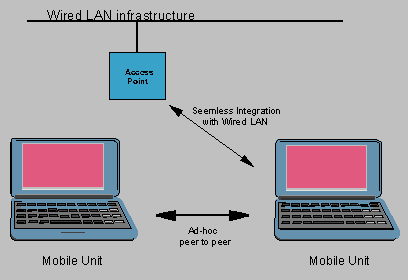
Figure 6 - Flexible networking without wires
The 802.11 standard also specifies quite a new idea, ad hoc 'peer-to-peer' wireless networking. This would allow two colleagues who may meet in an airport lounge or train station to establish an impromptu network through the air, and send data or a document between their respective devices. Another useful application would be in the meeting room, where an ad hoc network could be set up between participants' portable computers allowing on-the-spot information exchange. Alternatively there could be 'docking points' dotted around public places, allowing a roaming executive instant high bandwidth access to his corporate network obviating the need to plug anything in.
A first step towards this concept can be seen on the Apple Newton PDA which has an in-built infrared port. This allows data to be transferred when docked to a suitable desktop computer, or will enable passing PDAs to exchange their owner's electronic business cards.
Local area communications have fewer interoperability or regulatory considerations than wide area comms and therefore it is likely that many propriety solutions will be developed in niche markets, producing a multitude of features and ever impressive specifications.
Software
It is important to realise that data sent over wide area mobile networks is subject to very different conditions to those over a fixed one. Some applications can be converted to �work mobile�, whereas some will be written specifically for the new markets created. But in either case there are distinct differences for the applications and communications software involved in the mobile data system.
Software applications development
With most applications developed for static use, any limitations of the communications channel can almost be ignored - not so with mobile.
Modern LAN based applications are increasingly bandwidth hungry (packet data at 1 Mbit/s is standard), however developers will need to minimise their communications requirements over the wide area mobile network for two reasons -
- low kbit/s data rates on today�s networks
- usage has to be paid for
Data compression will help, however special attention must be given to the way in which information processing is organised within the application. Efficient data exchanges over the network will be essential if response times and user costs are to be kept down. The application must also accommodate unpredictable transmission delays on the mobile system, resulting from the network itself and variations on the end-end transmission path.
Of prime importance for any successful application is its ease of use. This is especially true for mobile systems which must perform in much more demanding conditions than any desk based system. There will be nowhere to store manuals whilst �on the road�, therefore GUIs, on screen help, minimum typing with menus and customised address books plus complete transparency of the network technicalities will be essential.
Communications software
The mobile data comms protocol must address the following -
- Robustness - to allow for momentary signal loss from inter cell handover or passing through tunnels to be handled with the minimum inconvenience or loss of data.
- Addressing - for individual users on the same and other mobile networks, plus fixed and international network identification.
- Protocol conversion - needed for interfacing to other networks and to reduce data redundancy in transactions between different networks.
- Security - important issue for the mobile data market. Corporate applications on private networks are often reasonably insecure, and to provide access to them from a mobile terminal is asking for trouble. Data encryption and other security techniques must be built in to the mobile application.
Systems Integration
Mobile data is already proven in specific vertical markets e.g. messaging systems for dispatchers, paging for field engineers etc. The technology is already in place to send bits of data over the airwaves, indeed there are many existing networks doing just that. What is missing is the integration of network and application. This is needed if the market is to broaden into a lucrative high user one addressing horizontal markets.
In the past the mobile network operators have worked closely with, for example a dispatch company and concentrated on how their specific mobile need can be met to improve efficiency. In doing this they have produced a tailored integrated solution, but with rather a limited wider appeal. There is a need to provide open interfaces for varied applications, packaging together user interfaces, terminal devices, mobile and fixed networks with attractive tariff structures.
One recent example of this is in the US where BellSouth and IBM have introduced a new product called 'Simon'. It is a portable hone, FAX, pager and personal organiser all in one. Based around a standard analogue cellular telephone, with built-in Group 3 AX acilities, the 2,400 bits/s CDPD modem allows access to Lotus cc:Mail, and an optional MobileComm PCMCIA card provides aging functions.
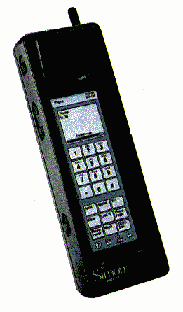
Figure 7 - IBM & BellSouth's 'Simon '
RAM Mobile Data is forming alliances with software houses, terminal manufacturers and system integrators in an attempt to stimulate the development of products and services for its network. They hope that their modular building blocks called RAMparts will enable licensed third parties to build wireless solutions for any computing platform.
The British company Communicate is packaging CLIC, a product which will allow dial up access to data on an office computer from an IBM ThinkPad notebook computer. Their PCMCIA modem card uses a Motorola mobile phone over Cellnet's network to transmit data, all controlled by Lotus Notes software. However priced at �600 for the PCMCIA card, initial take up is likely to be limited.
A slightly different approach is being developed by CNN and Reuters in delivering their information by enhanced broadcast teletext services. American company Hauppauge! is developing a Win/TV PCMCIA card which will enable portable computers to receive and process teletext data services, in addition to watching BBC1 in a Window !
The Future
One reason for the slow uptake in mobile data services, is the relatively low data rates achievable. These data rates are limited by the radio bandwidth licensed to networks. The FCC in the US have recently granted Mtel a licence for a Nationwide Wireless Network for wireless two-way data communications with a designated 3MHz of available radio spectrum. This should enable Mtel to develop much higher data rate applications which they are planning to deliver to standalone units, PCMCIA cards and PDAs via dedicated chipsets.
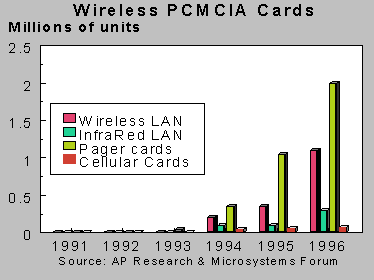
Figure 8 - PCMCIA forecasts
There may be similar opportunities in the UK, and there are a number of European research programmes working to specify what the next generation of mobile networks might look like around the year 2000. This includes the specification of; broadband facilities, a range of mobile terminals offering voice, data and video services, integration with the fixed network, and roaming between different network operators. PA Consulting predict that there will be 2 million users of two-way mobile data in the UK by the end of the decade.
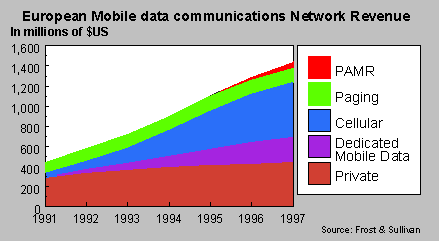
Figure 9 - Revenue forecasts for different solutions
In the near term future, it is likely that we will see more dual mode handsets capable of offering data services in addition to voice, such as paging over analogue cellular or GSM devices. Armed with a radio modem PCMCIA card slotted into his notebook, the wandering executive will ensure he is never far from his EMail account. Finally, the fashionable PDA may well change shape and functional emphasis, with less of the Newton's handwriting recognition and more of the Simon's communications.
Conclusions
There is nothing difficult about firing data around the airwaves, although no single universal solution will match all applications. The obstacle to mass takeup so far has been a distinct lack of sufficient vision and drive to provide simple, flexible and useful 'people friendly' applications. Given suitable integration there will be an explosion in mobile data applications
